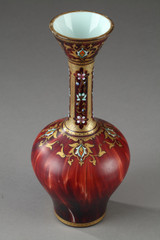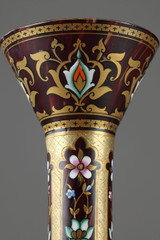bulbous opaline vase polychrome enamel and gold decoration composed of arabesques, flowers, and crosshatching in an oriental style on a marbled burgundy ground. Trace of a mark under the base. Late 19th century. Circa 1900
Condition report: Slight wear to the gilding on the edge of the collar.
Documentation:
The fascination with the Orient and its exotic decor dominated the 18th and 19th centuries. China was the origin of this craze for the customs and artistic forms of distant peoples. With each conquest and the establishment of colonial trading posts, the focus of this fascination shifted. In the 18th century, chinoiserie and turcorie styles invaded the salons and gardens of sovereigns and wealthy aesthetes who prided themselves on their taste for "the Orient." Baths were now Turkish, furniture lacquered, tapestries Persian, and cashmere shawls of Indian origin. In the following century, the Moorish style flourished with the Alhambra in Granada, and several Turkish boudoirs appeared in Europe. In the 19th century, Orientalism underwent a significant evolution. Thus, as early as 1829, Victor Hugo noted in the preface to his "Orientales" that "the Orient has become a general preoccupation." Discerning collectors are searching for an inaccessible or vanished elsewhere, fascinated by the unusual or the unprecedented, or simply seeking the extravagant satisfaction of a whim.
Delivery
Europe: €0
US/Canada/HK: €0
Rest of the world: Price upon request
- Reference :
- 1994
- Availability :
- Item available
- Width :
- 12 (cm)
- Height :
- 32 (cm)
- Depth :
- 12 (cm)
- Era:
- 20th century
- Style:
- orientalizing
- Materials:
- opal glass
























